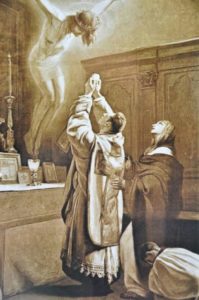QUAERITUR:
I came across an article that said in the Middle Ages there was a practice called Ocular Communion. Is this correct and if so what was meant by it?
“Ocular” has to do with the eyes (Latin oculus “eye”). Ocular Communion would be a grace-filled experience through looking at the Eucharist.
Yes, this was, and really still is, a thing, though we might frame it differently today.
Before modern understanding of how the eye works, it was thought the eye produced a kind of beam that touched the objects one saw, and then returned with information to the eye. The notion of “eye-contact” was virtually physical. Hence, one could “touch”, be in contact, with the Eucharist by looking at it.
During a period when physical, sacramental Communion was far more rare, seeing the Eucharist became more important, thus prompting the enrichment of rubrics for the Mass with the elevations, that allowed people present also to see the Eucharistic Host and the Chalice containing the Precious Blood.
For some people, and rightly so, the experience of the glimpse of the Eucharist was deeply meaningful and an opportunity for graces. This same longing belongs to those who spend time in adoration before the Blessed Sacrament exposed in a church or a chapel, or carried in procession.
In my seminary days the heretical and viciously incompetent faculty sneered at exposition, saying “Jesus said ‘take and eat’ not ‘sit and look’!” Oh, how very clever they thought themselves to be. Soooo very superior to our benighted troglodyte forebears.
We Catholics are both / and not either / or people. We can “take (receive) and eat” and also “sit and look”.
One of the best reasons for Eucharistic Adoration – even if it falls short of “ocular Communion” is related by the great St. John Vianney, the Curé d’Ars. St. John said there was a day laborer who always went into church whenever he passed by. He spent a lot of time in adoration of the Blessed Sacrament. The saint asked the man what he said to God when he was in church. The man answered, “Nothing. I look at Him and He looks at me.”
Eye contact.
While sacramental, physical Communion is wonderful for those who are in the state of grace, there is a great deal to be said for looking with longing on the Host, at the elevation or exposed. It could be part of a process of a return to the state of grace or else of far better sacramental Communions.



































I love that story related by St. John Vianney so much – thank you Fr. Z!
In French we have a slightly different version of the peasant’s answer to the Holy Curé of Ars. The peasant answered: “Je L’avise et Il m’avise” that is : “I advise (inform) Him and He advises me”.
As Father says: “seeing the Eucharist became more important, thus prompting the enrichment of rubrics for the Mass with the elevations, that allowed people present also to see the Eucharistic Host and the Chalice containing the Precious Blood.”
Eamon Duffy, in his wonderful “The striping of the Altars”, cites an example where the celebrant was not elevating the Host high enough and the congregation called out: “Hold up, Sir Priest, hold up!”
Apropos of the importance of seeing, I read in today’s Office of Readings an excerpt from St. Gregory of Nyssa’s homily (Orat. 6 De beautidinibus), where that holy Bishop reminds us that “In the language of Scripture, to see is to have.” What bliss, then, to see Our Blessed Lord in the Eucharist, for in a real way we then possess Him–or rather, He possesses us!
Pingback: Medieval Squints and Adoring Jesus in the Blessed Sacrament
I believe it is for this very reason that there are indulgences attached to saying, “My Lord and My God!” when gazing upon the Host and the Chalice at the Elevation of each.
Were the “striping of the altars” an earlier age’s vandalism of churches and of the statues of the saints? How times change– these days some advanced clerics even wear striped vestments!
A foretaste of Heaven… ” I look at Him and He looks at me”. I can hear in my head the old Hymn ( I was told as a child it was JFK’s favorite) “O God of Loveliness ” .
Thank you Father! I had heard something about this, but I hadn’t heard any explanation.